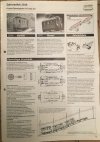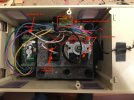We have a recently acquired loco - LGB 2046 (rack type) - but I cannot find any manuals for this specific model. I can find 24460 which is as near identical as far as I can see. I am told by the owner of the railway ours was bought as an analog only loco, the documents for the 24460 suggest it has a DCC decoder (MTS?).
Can I establish what sort of decoder is fitted to the 2046?
I can presumably put it on the programming track and check but I am not going to be able to visit the railway for some time. I brought the Loco home to take it apart to see what, if any, decoder has been fitted but I don't want to undertake surgery unless its absolutely necessary.
If anyone can enlighten me I would be grateful.
Robin
Can I establish what sort of decoder is fitted to the 2046?
I can presumably put it on the programming track and check but I am not going to be able to visit the railway for some time. I brought the Loco home to take it apart to see what, if any, decoder has been fitted but I don't want to undertake surgery unless its absolutely necessary.
If anyone can enlighten me I would be grateful.
Robin





